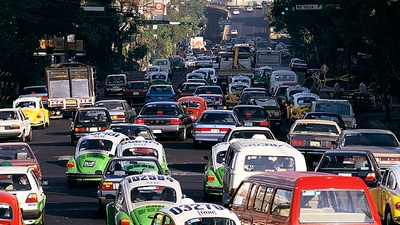Suggestions for Practical Action
Transport for Health was prepared by the World Bank-led Global Road Safety Facility and the Institute for Health Metrics and Evaluation at the University of Washington, with contributions from authors of other institutions, including: John Hopkins Bloomberg School of Public Health, Health Effects Institute, University of British Columbia, Schneider Institute for Health Policy, and Health Canada.
Building on previous Global Burden of Disease studies, it quantifies the health impacts from injuries due to road traffic crashes over the last two decades and air pollution from vehicles. It also highlights the growth in road deaths and injuries globally – deaths due to crashes were up 46 percent over two decades, and those from pollution rose 11 percent – and their substantial impacts on maternal and child health. It also notes the role safe roads in play in providing better health care and access to emergency aid.
The report proposes practical action countries can take now. Among the most important:
- Scale up road safety programs and crash reporting capacity to save lives and promote economic development.
- Promote strong institutional development for multi-sectoral collaboration in the emerging era of safe and clean mobility.
- Commit the resources needed to realize the health and economic gains from a safe and clean transport system.
- Systematically account for the health impact of road projects.
“The findings and recommendations of this report confirm the strong link between the health and transport sectors, and underline the importance of making all efforts toward safer and cleaner transportation,” says Karla Gonzalez, the Bank's transport manager for South Asia. “That’s why it is critical to support our client countries in implementing transport policies and systems that maximize economic benefits and minimize users’ risks.”
Some countries are already taking action, with projects that aim to address both transport and health-related challenges.
In India, for example, the World Bank-supported Mumbai Urban Transport Project aims to modernize transport by increasing the capacity of roads, buses and trains to keep up with urban migration. At the same time, the project introduces modern traffic management systems to reduce congestion, and pollution, on Mumbai’s choked roads.
In Vietnam, a project reduced accident rates in project corridors by 36 percent and deaths by 61 percent between 2005 and 2013. The project delivered 34,000 safety helmets to schools, completed a comprehensive national road safety campaign and trained 150 road engineers to act as Road Safety Auditors.
In Argentina, a road safety project also has contributed to saving lives: road crash fatalities declined by 12.5 percent in 2008-2011, while the number of registered vehicles rose by 15 percent in the same period. Moreover, this World Bank project fostered the creation of the first regional statistical database for road crashes: the Ibero-American Road Safety Observatory.
Better Data Needed
Another challenge to reversing the rise in transportation-related deaths has been a lack of data. Previous estimates of the global burden of road injuries have had minimal data from most countries. In this report, estimates of road injuries are constructed by analyzing a large number of measurements from even the regions that are considered information-poor.
The findings highlight the under-reporting of road crashes across the developing world. Estimates based on Global Burden of Disease 2010 data suggest, for example, that road injury deaths are more than twice the official statistics in India, four times those in China, and more than six times the official numbers in parts of Africa.
An absence of reliable accounting of health impacts is another challenge that not only endangers effective action across different sectors, but also can waste government resources or development aid that may be targeting ineffective interventions.
“Our report underscores the need for additional research on human exposure to air pollution in rapidly motorizing regions and to better understand the health effects of exposure to traffic-related pollutants,” explains Aaron J. Cohen, principal scientist at the Health Effects Institute. “Better data will enable us to better quantify the burden of disease due to traffic-related pollution and to track progress in reducing it.”


